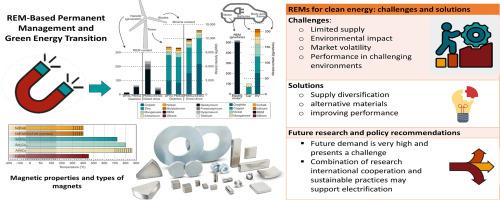Rare earth permanent magnets for the green energy transition: Bottlenecks, current developments and cleaner production solutions
IF 11.2
1区 环境科学与生态学
Q1 ENGINEERING, ENVIRONMENTAL
引用次数: 0
Abstract
Rare earth metals (REMs) are indispensable for producing high-performance permanent magnets, key components in many clean energy technologies, such as wind turbines. However, the limited availability and environmental impact of rare earth mining, processing, and purification pose challenges for the green energy transition. This review paper provides an overview of the main bottlenecks and challenges in using REM-based permanent magnets for clean energy applications, as well as current developments and potential solutions. First, the magnetic properties, permanent magnet development history, current uses and types of permanent magnets are described. Requirements for REM-based magnets in wind turbines and electric vehicles are then discussed, highlighting the demand and potential supply chain issues. Finally, the main bottlenecks and challenges related to rare earth ore availability, processing and recycling are identified. These challenges include: (1) geographical concentration of all rare earth oxide (REO) value chain portions; (2) environmental concerns (waste and process toxicity and energy requirements); (3) market volatility (fluctuating demand and supply), and geopolitics of the mineral value chain; and (4) performance (temperature stability, corrosion resistance and other usability factors). To address these challenges, the study presents current developments and potential solutions. This study thus provides a comprehensive understanding of the role of REOs in the energy transition and identifies future research directions and policy interventions that can ensure a sustainable and secure supply of REM-based permanent magnets for clean energy technologies.

用于绿色能源转型的稀土永磁体:瓶颈、当前发展和清洁生产解决方案
稀土金属 (REM) 是生产高性能永久磁铁不可或缺的材料,也是风力涡轮机等许多清洁能源技术的关键部件。然而,稀土开采、加工和提纯过程中的有限可用性和对环境的影响给绿色能源转型带来了挑战。本综述文件概述了将基于稀土的永磁体用于清洁能源应用的主要瓶颈和挑战,以及当前的发展和潜在的解决方案。首先,介绍了永磁体的磁性能、永磁体的发展历史、当前用途和类型。然后,讨论了风力涡轮机和电动汽车对基于 REM 的磁体的要求,强调了需求和潜在的供应链问题。最后,确定了与稀土矿供应、加工和回收相关的主要瓶颈和挑战。这些挑战包括(1) 所有稀土氧化物 (REO) 价值链部分的地理集中性;(2) 环境问题(废物和加工毒性以及能源需求);(3) 市场波动性(供需波动)和矿物价值链的地缘政治;以及 (4) 性能(温度稳定性、耐腐蚀性和其他可用性因素)。为应对这些挑战,本研究介绍了当前的发展情况和潜在的解决方案。因此,本研究全面了解了 REO 在能源转型中的作用,并确定了未来的研究方向和政策干预措施,以确保用于清洁能源技术的基于 REM 的永磁体的可持续安全供应。
本文章由计算机程序翻译,如有差异,请以英文原文为准。
求助全文
约1分钟内获得全文
求助全文
来源期刊

Resources Conservation and Recycling
环境科学-工程:环境
CiteScore
22.90
自引率
6.10%
发文量
625
审稿时长
23 days
期刊介绍:
The journal Resources, Conservation & Recycling welcomes contributions from research, which consider sustainable management and conservation of resources. The journal prioritizes understanding the transformation processes crucial for transitioning toward more sustainable production and consumption systems. It highlights technological, economic, institutional, and policy aspects related to specific resource management practices such as conservation, recycling, and resource substitution, as well as broader strategies like improving resource productivity and restructuring production and consumption patterns.
Contributions may address regional, national, or international scales and can range from individual resources or technologies to entire sectors or systems. Authors are encouraged to explore scientific and methodological issues alongside practical, environmental, and economic implications. However, manuscripts focusing solely on laboratory experiments without discussing their broader implications will not be considered for publication in the journal.
 求助内容:
求助内容: 应助结果提醒方式:
应助结果提醒方式:


